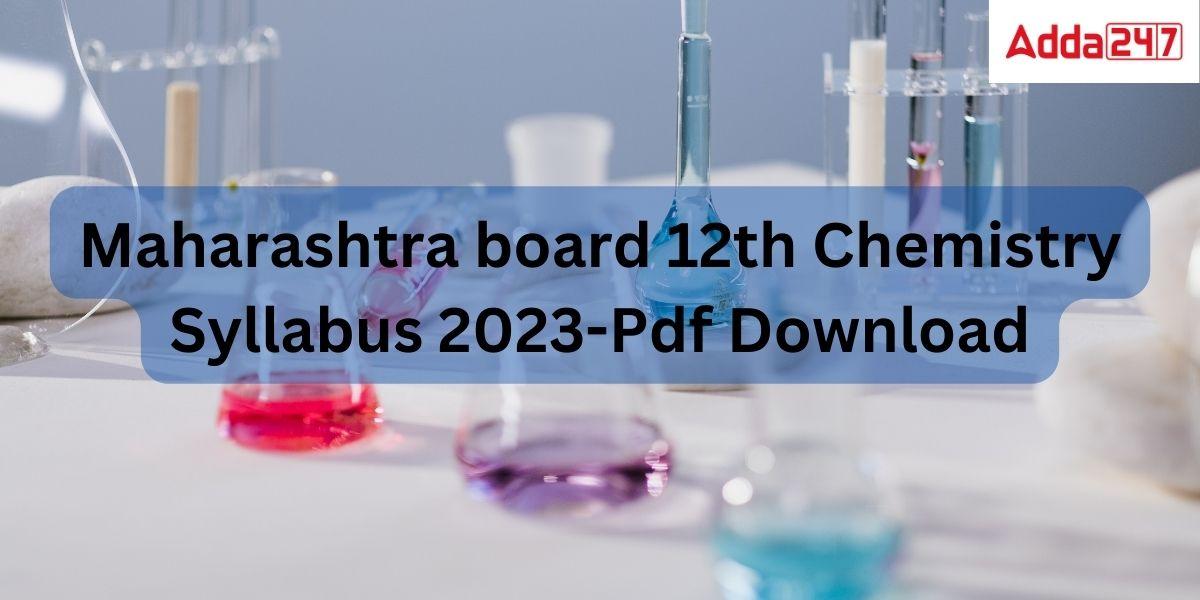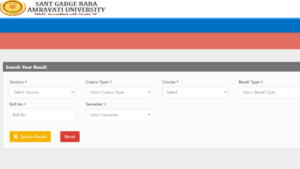Maharashtra Board HSC 12th Chemistry Syllabus 2023
Maharashtra board 12th Chemistry Syllabus 2023:One of the most important subjects in the science stream in class 12 is chemistry, which is also essential to take higher-level engineering and medical exams. To save the time and energy of students, we have given the Maharashtra board 12th Chemistry Syllabus 2023 in a complete manner on this page. The students must thoroughly read the provided Maharashtra board 12th Chemistry Syllabus 2023.
Check out:CBSE Class 12 Chemistry Syllabus 2023
Maharashtra Board HSC 12th Chemistry Syllabus 2023:Unit wise
Unit 1: Solid State
Classification of solids based on different forces; molecular, ionic, covalent and metallic solids, amorphous and crystalline solids (elementary idea), unit cell in two dimensional and three dimensional lattices, calculation of density of unit cell, packing in solids, voids, number of atoms per unit cell in a cubic unit cell, point defects, electrical and magnetic properties, Band theory of metals, conductors and semiconductors and insulators and n and p-type semiconductors.
Unit 2: Solutions and colligative properties
Types of solutions, expression of concentration of solids in liquids, solubility of gases in liquids, solid solutions, colligative properties –relative lowering 161 of vapor pressure, Raoult’s law elevation of boiling point, depression of freezing point, osmotic pressure, determination of molecular masses using colligative properties, abnormal molecular mass. Van’t Hoff factor and calculations involving it.
Unit 3: Chemical thermodynamics and energetic
Concepts of system, types of systems, surroundings. Work, heat, energy, extensive and intensive properties, state functions. First law of thermodynamics – internal energy and enthalpy, Hess’ law of constant heat summation, enthalpy of bond dissociation, combustion, formation, atomization, sublimation. Phase transition, ionization and solution and dilution Introduction of entropy as a state function, free energy change for spontaneous and non spontaneous processes, and equilibrium constant. Second and third law of thermodynamics.
Unit 4: Electrochemistry
Redox reactions, conductance in electrolytic solutions, specific and molar conductivity, variations of conductivity with concentration, Kohlrausch’s Law, electrolysis and laws of electrolysis (elementary idea), dry cell –electrolytic and galvanic cells; lead accumulator, EMF of a cell, standard electrode potential, Nernst equation and its application to chemical cells, fuel cells; corrosion. Relation between Gibb’s energy change and emf of a cell.
Unit 5: Chemical kinetics
Rate of reaction (average and instantaneous), factors affecting rate of reaction; concentration, temperature, catalyst; order and molecularity of a reaction; rate law and specific rate constant, integrated rate equations and half life (only for zero and first order reactions); concept of collision theory (elementary idea, no mathematical treatment). Activation energy, Arrhenius equation.
Unit 6 : General principles and processes of isolation of elements
Principles and methods of extraction – concentration, oxidation, reduction electrolytic method and refining; occurrence and principle of extraction of aluminium, copper, zinc and iron.
Unit 7: p-Block elements
Group 15 elements:
General introduction, electronic configuration, occurrence, oxidation states, trends in physical and chemical properties; nitrogen – preparation, properties and uses; compounds of nitrogen; preparation and properties of ammonia and nitric acid, oxides of nitrogen (structure only); Phosphorous-allotropic forms; compounds of phosphorous; preparation and properties of phosphine, halides (PCl3, PCl5 ) and oxoacids (elementary idea only).
Group 16 elements:
General introduction, electronic configuration, oxidation states, occurrence, trends in physical and chemical properties; dioxygen; preparation, properties and uses; Classification of oxides, simple oxides; Ozone. Sulphur – allotropic forms; compounds of sulphur; preparation, properties and uses of sulphur dioxide; sulphuric acid; industrial process of manufacture, properties and 162 uses, oxoacids of sulphur (structures only).
Group 17 elements:
General introduction, electronic configuration, oxidation states, occurrence, trends in physical and chemical properties; compounds of halogens; preparation, properties and uses of chlorine and hydrochloric acid, interhalogen compounds, oxoacids of halogens (structure only).
Group 18 elements:
General introduction, electronic configuration. Occurrence, trends in physical and chemical properties, uses.
Unit 8 : d and f Block Elements
d-Block Elements:
General introduction, electronic configuration, occurrence and characteristics of transition metals, general trends in properties of the first row transition metals – metallic character, ionization enthalpy, oxidation states, ionic radii, colour, catalytic property, magnetic properties, interstitial compounds, alloy formation preparation and properties of K2 Cr2 O7 and KMnO4.
f-Block elements –
Lanthanoids – Electronic configuration, oxidation states, chemical reactivity and lanthanoid contraction and its consequences.
Actinoids – Electronic configuration, oxidation states. Comparison with lanthanoids
Unit 9: Coordination compounds
Coordination compounds – Introduction, ligands, coordination number, colour, magnetic properties and shapes, IUPAC nomenclature of mononuclear coordination compounds, bonding; Werner’s theory, VBT, CFT. isomerism, (structural and stereo) importance of coordination compounds (in qualitative analysis, extraction of metals and biological systems).
Unit 10: Halogen derivatives of alkanes (and arenes)
Haloalkanes :
Nomenclature, nature of C-X bond, physical and chemical properties, mechanism of substitution reactions. Stability of carbocations, R-S and d-l configuration
Haloarenes :
Nature of C-X bond, substitution reactions (directive influence of halogen for monosubstituted compounds only) stability of carbocations, R-S and d-l configurations. Uses and environmental effects of – dichloromethane, thrichloromethane, tetrachloromethane, iodoform, freons, DDT
Unit 11: Alcohols, phenols and ethers
Alcohols:
Nomenclature, methods of preparation, physical and chemical properties (of primary alcohols only); identification of primary, secondary and tertiary alcohols; mechanism of dehydration, uses of methanol and ethanol.
Phenols:
Nomenclature, methods of preparation, physical and chemical properties, acidic nature of phenol, electrophillic substitution reactions, uses of phenols.
Ethers:
Nomenclature, methods of preparation, physical and chemical properties, uses
Unit 12: Aldehydes, ketones and carboxylic acids
Aldehydes and ketones:
Nomenclature, nature of carbonyl group, methods of preparation. Physical and chemical properties, mechanism of nucleophilic addition, reactivity of alpha hydrogen in aldehydes; uses.
Carboxylic acids:
Nomenclature, acidic nature, methods of preparation, physical and chemical properties; uses.
Unit 13: Organic compounds containing nitrogen
Nitro compounds-General methods of preparation and chemical reactions
Amines:
Nomenclature, classification, structure, methods of preparation, physical and chemical properties, uses, identification of primary, secondary and tertiary amines.
Cyanides and isocyanides:
Will be mentioned at relevant places in context
Diazonium salts: Preparation, chemical reactions and importance in synthetic organic chemistry.
Unit 14: Biomolecules
Carbohydrates:
Classification (aldoses and ketoses), monosaccharides d-l configuration (glucose and fructose), oligosaccharides (sucrose, lactose, maltose), polysaccharides (starch, cellulose, glycogen), importance.
Proteins:
Elementary idea of α -amino acids, peptide, linkage, polypeptides, proteins; structure of amines-primary, secondary, tertiary structure and quaternary structures (qualitative idea only), denaturation of proteins; enzymes
Lipids and hormones (elementary idea) excluding structure, their classification and functions
Vitamins: Classification and functions. Nucleic acids: DNA and RNA
Unit 15: Polymers
Classification – natural and synthetic, methods of polymerization (addition and condensation), copolymerization. Some important polymers; natural and synthetic like polythene, nylon, polyesters, bakelite, and rubber. Biodegradable and non-biodegradable polymers.
Unit 16: Chemistry in everyday life
- Chemicals in medicines : analgesics, tranquillizers, antiseptics, disinfectants, antimicrobials, antifertility drugs, antibiotics, antacids, antihistamines elementary idea of antioxidants
- Chemicals in food :Preservatives, artificial sweetening agents.
- Cleansing agents : Soaps and detergents, cleansing action
Maharashtra Board HSC 12th Chemistry Syllabus 2023: Practical Syllabus
A. Chemical Kinetics
(Any one of the following) :
(a) Effect of concentration and temperature on the rate of reaction between sodium thiosulphate and hydrochloric acid.
(b) Study of reaction rate of any one of the following:
(i) Reaction of iodide ion with hydrogen peroxide at room temperature using different concentration of iodide ions.
(ii) Reaction between potassium iodate, KIO3 and sodium sulphite (Na2SO3) using starch solution as indicator
(clock reaction).
(c) Acid hydrolysis of ethyl acetate.
B. Thermochemistry
Any one of the following experiments:
i] Enthalpy of dissolution of copper sulphate or potassium nitrate.
ii] Enthalpy of neutralization of strong acid (HCl) and strong base (NaOH).
iii] Determination of enthalpy change during interaction (hydrogen bond formation) between acetone and chloroform.
iv] Heat of displacement of Cu from CuSO4 by Zn.
C. Electrochemistry Variation of cell potential in Zn|Zn2+||Cu2+|Cu with change in concentration of electrolytes (CuSO4 or ZnSO4) at room temperature (demonstration).
D. Chromatography (demonstration)
(i) Separation of pigments from extracts of leaves and flowers by paper chromatography and determination of Rf
values.
(ii) Separation of constituents present in an inorganic mixture containing two cations only (constituents having large difference in Rf values to be provided).
E. Preparation of Inorganic Compounds
(i) Preparation of double salt of ferrous ammonium sulphate or potash alum.
(ii) Preparation of potassium ferric oxalate.
F. Preparation of Organic Compounds
(i) p-Nitrocetanilide
(ii) Aniline yellow or 2- Napthol aniline dye.
(iii) Iodoform
(iv) Phthalic or succinic anhydride.
(v) Di-benzal acetone
G. Tests for the functional groups present in organic compounds
Unsaturation, alcoholic, phenolic, aldehydic, ketonic, carboxylic and amino (primary) groups.
H. Characteristic tests of carbohydrates, fats and proteins in pure samples and their detection in given food stuffs.
I. Determination of concentration/molarity of KMnO4 solution by titrating it against a standard solution of:
(i) Oxalic acid
(ii) Ferrous ammonium sulphate
(Students will be required to prepare standard solutions by weighing themselves).
J. Qualitative analysis
1) Determination of two cations from a given mixture of salts.
2) Determination of two anions from a given mixture of salts.

(Note: Insoluble salts excluded.)
Maharashtra Board HSC 12th Chemistry Syllabus 2023:Project
Scientific investigations involving laboratory testing and collecting information from other sources.
A few suggested Projects:
1 Study of presence of oxalate ions in guava fruit at different stages of ripening.
2 Study of quantity of casein present in different samples of milk.
3 Preparation of soyabean milk and its comparison with natural milk with respect to curd formation, effect of
temperature, etc.
4 Study of the effect of potassium bisulphate as food preservative under various conditions (temperature, concentration,time etc).
5 Study of digestion of starch by salivary amylase and, effect of pH and temperature on it.
6 Comparative study of the rate of fermentation of following materials: wheat flour, gram flour, potato juice, carrot juice, etc.
7 Extraction of essential oils present in Saunf (aniseed), Ajwain (carum), Illaichi (cardamom).
8 Study of common food adulterants in fat, butter, sugar, turmeric powder, chilli powder and pepper.
Note : Any investigatory project, can be chosen with the approval of the teacher.
Maharashtra Board HSC 12th Chemistry syllabus 2023 Pdf Download
The first step to taking the Maharashtra class 12 board Exam 2023 is to understand the Maharashtra board 12th Chemistry Syllabus 2023. Download the Maharashtra board 12th Chemistry Syllabus 2023 and gear up your board exam preparation.Click the below Link.
Maharashtra Board HSC 12th Chemistry Syllabus 2023-FAQs
Q.How many units are there in the Maharashtra board 12th Chemistry Syllabus 2023?
Maharashtra board 12th Chemistry Syllabus 2023 consists of 16 units. The units of Maharashtra board 12th Chemistry Syllabus 2023 are Solid State, Solutions and colligative properties, Chemical thermodynamics and energetic, Electrochemistry, Chemical kinetics, General principles and processes of isolation of elements,p-Block elements,d and f Block Elements, Coordination compounds, Halogen derivatives of alkanes (and arenes), Alcohols, phenols and ethers, Aldehydes, ketones and carboxylic acids, Organic compounds containing nitrogen, Biomolecules, Polymers, Chemistry in everyday life.
Q.Which kinds of questions are included in the Maharashtra board 12th Chemistry Syllabus 2023?
The Maharashtra board 12th Chemistry Syllabus 2023 comprises MCQs, test series, short-answer questions, and long-answer questions.
Q.How can I get Maharashtra board 12th Chemistry Syllabus 2023 Pdf?
You can download the Maharashtra board 12th Chemistry Syllabus 2023 pdf from this page. To get the syllabus of other subjects the students can visit the official website of Adda247 School.











 BTEUP Result 2025 Out at bteup.ac.in, Do...
BTEUP Result 2025 Out at bteup.ac.in, Do...
 SGBAU Result 2025 Out, Check Summer Seme...
SGBAU Result 2025 Out, Check Summer Seme...
 How To Prepare for CUET Accountancy Exam...
How To Prepare for CUET Accountancy Exam...

